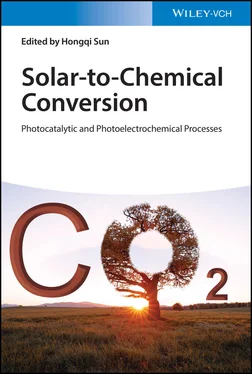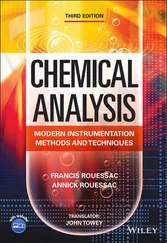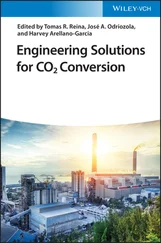3 Chapter 4Figure 4.1 Schematic illustration of photocatalytic hydrogen generation over a semiconductor photocatalyst [8].Figure 4.2 Band levels of various semiconductor photocatalysts. Source: Lu et al. [15].Figure 4.3 Schematic cells for rutile phase (a) and anatase phase (b) of TiO 2. Source: Thompson and Yates [16].Figure 4.4 Photocatalytic H 2evolution of pure TiO 2, Degussa P25, and TiO 2with different amounts of Zn. Source: Al‐Mayman et al. [25].Figure 4.5 Hydrogen evolution on the bare and metallic TiO 2photocatalysts using the benchmark Degussa P25 TiO 2and its bimetallic materials as the references. Source: Wang et al. [26].Figure 4.6 Photocatalytic hydrogen evolution on TiO 2‐supported Au–Pd nanoparticles using a range of alcohols. Source: Su et al. [27].Figure 4.7 Schematic representation of the band structure of pure and N‐doped anatase TiO 2. Note that the energies are not in scale. Source: Di Valentin et al. [32].Figure 4.8 The photocatalyst H 2generation rate of 2.5 wt%‐Cu 2O/TiO 2with different sacrificial reagents. Source: Li et al. [34].Figure 4.9 (a) The energy band structure of ZnO/ZnS heterojunction. (b) The graphic structure of ZnO‐dotted ZnS. Source: Wu et al. [37].Figure 4.10 Tri‐ s ‐triazine‐based structure of g ‐C 3N 4. The C and N atoms are indicated by gray and blue balls [8].Figure 4.11 Photocatalytic H 2production over the bulk C 3N 4, C 3N 4NSs, and C 3N 4NTs under visible‐light irradiation. Source: Zhu et al. [54].Figure 4.12 Graphic design of preparation of cobalt‐doped g ‐C 3N 4. Source: Chen et al. [57].Figure 4.13 (a) EIS, (b) photocurrent response, and steady‐state (c) and transient (d) PL spectra of g ‐C 3N4 and B‐doped g ‐C 3N 4samples. Source: Chen et al. [60].Figure 4.14 Schematic illustration of the charge transfer for the three types of heterojunctions [8].Figure 4.15 Graphic illustration of the proposed mechanism for cobalt oxide/C 3N 4NT heterojunction for photocatalytic H 2evolution. Source: Zhu et al. [61].Figure 4.16 Schematic diagram of the photocatalytic mechanism in WO 3/MCN. Source: Kailasam et al. [63].Figure 4.17 The average H 2evolution rate of the SiC nanowires and modified SiC nanowires. Source: Hao et al. [66].Figure 4.18 Illustration of lanthanide upconversion nanoparticles (UCNPs).Figure 4.19 Illustrative diagrams of energy transfer among NYFG(15)/C 3N 4NTs. Source: Zhu et al. [67].Figure 4.20 The proposed mechanism of the improved photocatalytic activity in the N‐CDs/CdS photocatalyst. Source: Shi et al. [69].Figure 4.21 Graphic diagram of the FeS 2–TiO 2heterostructures under ultraviolet, visible, and NIR light irradiation for photocatalytic H 2evolution. Source: Kuo et al. [71].Figure 4.22 (a) The UV–vis near‐infrared absorption spectrum. (b) Photocatalytic hydrogen evolution for amorphous TiO 2–x. Source: Jiang et al. [74]Figure 4.23 Methanol and its dissociative species underwent two‐electron oxidation in photocatalytic H 2production process over Au–Pt alloyed TiO 2nanocomposites. Source: Al‐Mayman et al. [25].
4 Chapter 5Figure 5.1 The schematic illustration of the features of H 2production by PV + EC, PEC, and PC in the five aspects of cost, STH efficiency, technology readiness, H 2/O 2separation, and catalyst stability.Figure 5.2 The schematic illustration of three steps in PEC water splitting process. Source: From Wang and Wang [7]. © 2018 Elsevier.Figure 5.3 The illustration of semiconductor–electrolyte interface and the corresponding band bending. (a, b) The scheme and energy level of semiconductor and electrolyte in vacuum. The electrons are uniformly distributed around the core of atoms (blue dot). (c, d) The schematic illustration of electron distribution and the energy band bending when SEI is built. The electrons (red dot) are accumulated at the SEI interface. (e, f) The schematic illustration of electron–hole separation and transfer under illumination.Figure 5.4 (a) The oxygen vacancy concentration change by adjusting the treatment duration in N 2. (b) The volcano relationship between photocurrent and oxygen vacancy concentration. Source: Wang et al. [39]. © 2019 Willey.Figure 5.5 (a) The schematic charge transfer in particulate Ta 3N 5photoanode. (b) The change of charge separation and transfer efficiency for Ta 3N 5photoanode when the charge transfer and generation are improved gradually. Source: Wang et al. [45]. Licensed under CC BY 3.0 Unported.Figure 5.6 (a) The image and (b) the photoresponse (red curve) of branched 2D porous TiO 2single‐crystal nanosheet photoelectrode. Insert (a) illustrates the photocharge transfer during PEC process. Source: Butburee et al. [71]. Reproduced with the permission from Wiley.Figure 5.7 (a) The surface state distribution characterization by cyclic voltammetry (CV) and the surface state related capacitance ( C ss). The different hematite photoelectrodes are compared including Ti doping, Al 2O 3passivation, and H 2O 2treatment. (b) The schematic illustration of PEC reaction via the surface states as intermediates. Source: From Wang et al. [8]. © 2016 Royal Society of Chemistry.Figure 5.8 The schematic illustration of cocatalyst design strategy based on a charge storage layer between the semiconductor and the effective cocatalyst layer.Figure 5.9 The schematic illustration of three different types of unbiased PEC water splitting systems. PA, PC, and PV represent photoanode, photocathode, and photovoltaic, respectively. The j – E curves represent their photoresponses in a three‐electrode system. The intersections (red dots) indicate the unbiased operation points.
5 Chapter 6Figure 6.1 Schematic illustration of photocatalytic oxygen evolution systems: (a) homogeneous and (b) heterogeneous configuration.Figure 6.2 Structures of (a) PS‐II‐OEC natural WOCs and (b) λ‐MnO 2, (c) Mn 4O 4L 6core, and (d) Co 4O 4(Ac) 4(py) 4artificial WOCs. Source: From McCool et al. [27]. © 2011 American Chemical Society.Figure 6.3 Ball‐and‐stick model of (a) Mn 4POM core, (b) polyhedral Mn 4POM, and (c) S 0state of the natural OEC model. (d) Cycle diagram for the electron transfer within the S 0→ S 4Kok cycle of the natural PS‐II‐OEC. (e) Photocatalytic oxygen evolution of Mn 4POM within the [Ru(bpy) 3] 2+/Na 2S 2O 8system. Source: From Al‐Oweini et al. [20]. © 2014 John Wiley & Sons.Figure 6.4 Illustration of the band positions of common semiconductor materials and the energy level toward water splitting.Figure 6.5 Comparison of electronic DOS of (a) 3D bulk semiconductor materials and LD semiconductor materials including (b) 2D, (c) 1D, and (d) 0D. The inset arrows on related models indicate the quantum confinement direction and dimensionalities. (e) Quantum size effect on band structure. (f) Schematic illustration of surface plasmon resonance excitation on metallic NPs.Figure 6.6 (a) TEM image of WO 2.83NRs. (b) LSPR in 1D WO 2.83NRs (experimental measurement and theoretical simulation). Source: Manthiram and Paul Alivisatos [55].Figure 6.7 (a–c) TEM images and (d) size distributions of Co 3O 4NPs with different diameters (3, 10, and 40 nm). (e) The relationship between particle diameter and surface area. Inset: Images of NPs in the form of powder or dispersed in water. (f) Visible‐light‐ driven oxygen evolution of Co 3O 4NPs with different diameters using Ru(bpy) 3 2+as the sensitization system. (g) Visible‐light‐driven oxygen evolution from various cobalt compounds placed on SBA‐15. Source: Reproduced with permission. Grzelczak et al. [69]. Copyright 2013, American Chemical Society.Figure 6.8 (a) TEM image and (b) Mott–Schottky plots for CoO NPs and micropowders. The flat band potentials are obtained via extrapolation method. (c) Band positions of CoO NPs and micropowders according to the band gaps and flat band potentials. Source: Reproduced with permission Liao et al. [77]. Copyright 2014, Nature Publishing Group.Figure 6.9 (a) TEM image quantum‐sized BiVO 4. (b) Comparison of the band position of nanoscale BiVO 4and quantum‐sized BiVO 4. Source: Reproduced with permission. Sun et al. [89]. Copyright 2014, American Chemical Society.Figure 6.10 (a) Tungsten oxide single‐crystal nanosheets. (b,c) HRTEM images of WO 3, WO 3−x‐VT, and WO 3−x‐HT nanosheets. (d) Band position regulation of WO 3nanosheets with oxygen vacancies. Source: From Yan et al. [58]. © 2015 John Wiley & Sons.Figure 6.11 (a) Representation of charge transfer between (001) and (110) facets. (b) Detachment and transfer of photoexcited charges in the BiOCl and defect‐rich BiOCl. (c) TEM image of the defect‐rich BiOCl ultrathin nanosheets. (d) Photocatalytic OER for BiOCl and defect‐rich BiOCl. Source: Reproduced with permission. Di et al. [107]. Copyright 2017, the Royal Society of Chemistry.Figure 6.12 The photocatalytic properties of LD materials including light absorption and charge transfer can be improved by doping engineering, active facet exposure, defect or vacancy creation, and LSPR. Hybrid LD materials with heterojunction can also be constructed in the form of 0D/1D, 1D/1D, 0D/2D, and 2D/2D configurations.Figure 6.13 (a,b) TEM images. (c) Time dependence of the O 2evolution. (d) Proposed energy diagram for Co(OH) 2/TiO 2. Source: Reproduced with permission. Maeda et al. [110]. Copyright 2016, Wiley‐VCH.
Читать дальше


![Евгений Матерёв - Музеи… или вдохновляющая музыка The Chemical Brothers [litres самиздат]](/books/437288/evgenij-materev-muzei-ili-vdohnovlyayuchaya-muzyka-th-thumb.webp)









